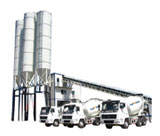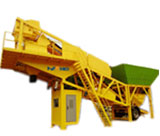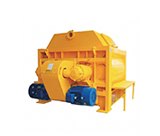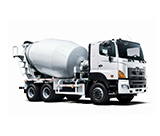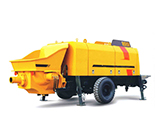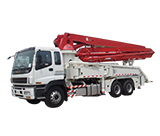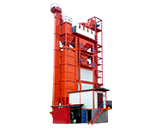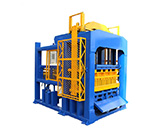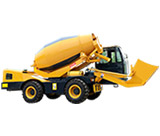Wet Mix Concrete Batching Plant
2025.09.19
A wet mix concrete batching plant, also known as a wet batch concrete plant, measures and mixes raw materials such as cement, aggregate, water and admixtures in a specific ratio to produce wet-mix concrete that meets quality requirements. Wet mix concrete plants produce more uniform concrete quality because water is added during the mixing process, ensuring consistent moisture content in each batch. They also offer faster production speeds, allowing for simultaneous loading of both dry and wet materials, reducing mixing time. They are also more efficient because the mixers are constantly refilled with water, reducing cleaning and downtime. They also generate less dust and debris, making them more environmentally friendly.


The output range of a wet mix concrete batching plant varies depending on the model and manufacturer, but generally ranges from 25 to 300 m³/h.
Main Components
- Raw Material Storage System:
Consists of raw material tanks and other components for storing raw materials such as cement, sand, gravel, thickening powder, and admixtures.
- Conveyor System:
Comprised of screw conveyors and belt conveyors, these systems transport raw materials from the storage tanks to the metering and mixing systems.
- Metering System:
High-precision sensors are used to precisely measure water, cement, sand, fly ash, and admixtures to ensure the correct mix ratio of concrete.
- Mixing System:
Typically, a JS series twin-shaft concrete mixer is used. These mixers feature uniform mixing, no dead spots, no water leakage, and rapid material discharge, effectively blending various raw materials into a uniform concrete mix.
- Control System:
Typically, a computer is used, offering intuitive operation, accurate control, and automatic error correction, enabling automated control of the mixing station and recording and analysis of production data.
- Dust Removal System:
Pulse bag dust collectors are often used to recover dust from the production process, reducing dust emissions and contributing to environmental protection.
The operating principle of a wet mix concrete batching plant can be simplified into three core steps: "precise batching → centralized mixing → finished product output." An automated system links these steps to rapidly produce qualified wet-mix concrete. The specific process is as follows:
- Raw Material Preparation and Metering:
Each raw material (aggregate, cement, water, and admixtures) is removed from dedicated storage units (aggregate silo, cement tank, water tank, and admixture tank) and accurately weighed (within ±1%) according to the preset mix ratio by a metering system.
- Centralized Mixing:
The measured raw materials are simultaneously fed into a twin-shaft forced concrete mixer. High-speed shearing and tumbling by the blades thoroughly mix the dry and wet materials within 30-90 seconds, ensuring a homogeneous concrete.
- Finished Product Output and Equipment Reset:
After mixing is complete, the mixer discharge door is opened and the wet-mix concrete is unloaded into a tanker truck (which rotates at a low speed to prevent segregation). The mixer and metering components are then cleaned, and the equipment is reset to prepare for the next batch of production.
The application scope of wet mix concrete batching plants focuses on scenarios requiring a stable, large-scale supply of high-quality concrete, covering four main categories:
- Civil/commercial construction:
Foundations, beams, columns, and floor slabs for high-rise residential buildings, office buildings, and shopping malls;
- Transportation infrastructure:
Main structure and foundation construction for highways, bridges, tunnels, subways, and airport runways;
- Water conservancy/municipal engineering:
Reservoirs, dams, river embankments, sewage treatment plants, urban road paving, and pipeline foundations;
- Industrial/special engineering:
Heavy-duty factory equipment foundations, power plant cooling towers, and large-span structures for large venues.
The market share of wet mix concrete batching plants may vary across regions and countries. Generally speaking, wet-mix concrete is favored by many construction companies due to its excellent fluidity and ease of construction. In large cities and rapidly developing regions, wet-mix concrete batching plants have a higher market share.

